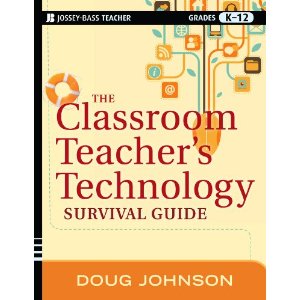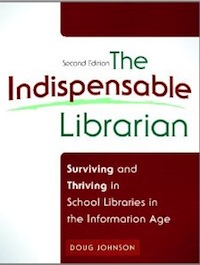Everything I know about engagement I learned in kindergarten
Everything I know about engagement I learned in kindergarten
Doug Johnson
Head for the Edge, October 2013
Studies show that the more time students spend in school, the more disengaged they become.
A recent Gallup Student Poll1 shows that while 76% of students are engaged while in elementary school, the number drops to only 44% in high school. Brandon Busteed, Executive Director of Gallup Education, concludes:
The drop in student engagement for each year students are in school is our monumental, collective national failure. There are several things that might help to explain why this is happening — ranging from our overzealous focus on standardized testing and curricula to our lack of experiential and project-based learning pathways for students — not to mention the lack of pathways for students who will not and do not want to go on to college.
Do these findings surprise anyone? In my own teaching experience and from listening to my own children, this is an accurate poll. The only change I’d make would be to extend the engagement drop right through the first two years of college before the direction moves upward again when general education requirements are met - and students get to tackle subjects that are actually of interest to them.
As Busteed suggests, correlations between engagement, relevance, and project-based learning can be easily and correctly drawn. I’ve been fussing about the need for concrete ways to improve projects since, oh, about 1999. And it’s obvious nobody has been listening and now look what’s happened.
Perhaps our elementary colleagues know something about engagement that secondary educators don’t? It’s been more than a couple years since I attended kindergarten, but I remember it as three of the best years of my life (old joke). Anyway…
Everything I know about engagement I learned in kindergarten with apologies to Robert Fulghum.
In kindergarten you get
-
To show and tell. You got to do something or bring something and then tell others about it. Secondary skill attainment measurement needs to be less about testing and more about show and tell - I mean performance-based assessment. Oh, and listening to other students is a lot more involving than listening to the old person at the front of the room. How often do we allow students to speak?
-
To have choices. As a little kid you often got to choose - your library book, your reading buddy, your activity, the subject of your drawing. People tend to choose things that interest them and interesting things are engaging. How often do we let older students choose what and how they learn?
-
To play. Elementary teachers can make a game out of almost anything - and make just about every task feel like play. The older we get, the less we get to play and more we have to work. Just why is that? Gamification is a fancy term for putting play back into the curriculum. Look it up. Does your library promote gaming?
-
To take naps. Most adolescents I know are tired - and not because they’ve been up all night texting. Well, maybe that’s part of it. We’ve long known that teens do better when school starts later in the morning. Tired people have a tough time staying engaged. Is napping an acceptable behavior in your library?
-
To go outside. The best learning takes place in the “real world” not in the classroom. Whether it is studying bugs and leaves in first grade, marching with the band in junior high, or doing service learning as seniors, we all are more interested when it is the real world with which we are dealing. Do we encourage students to use primary sources in their research such as local experts, local historical curations, and other extra-school resources?
-
To color. A blank sheet of construction paper and some crayons have always let young learners be creative. Creativity is inherently engaging. What’s the high school classroom’s equivalent to scissors and paste? Does your library encourage creativity?
-
To do it together. Reading groups. Play groups. Science groups. It’s better with other kids. Social learners are engaged learners. Is your library a social learning space?
-
To read for enjoyment. Our elementary teachers and librarians wanted us to practice reading so much they let us read what we actually liked. Do our secondary teachers want us to write so much, know so much, experiment so much, and solve problems so much that we get to do it for enjoyment? Do our libraries stock popular materials that are read because of personal interest, not just for curricular purposes?
-
To learn things that are important. Nobody needs to convince a little kid that learning to read, to count coins, or to know about firefighters is important - and that you should pay attention when being taught these things. Do teachers start with the “why” of calculus, world economics, the Romantic poets, or the atomic structure of non-metals? Not so much. If you can’t convince me what you are teaching should be important to me, teach something that is We need to take the concepts of “Connected Learning”2 seriously.. Can we librarians figure out how to connect required class work to our students’ lives?
-
To feel cared about. Yes, this should have been the first one. I really believe a lot of little kids are engaged because they know someone cares that they are. Yeah, the littlies are cute and cuddly and all that, but the gangly, awkward, homely teens need to know adults care too. When someone else is paying attention to you, you pay more attention yourself. Librarians, are we adopting those kids who no one else seems to care much about?
There you are - 10 simple steps to keep the engagement level from tanking - all things kindergarten teachers just seem to do.
1. Busteeed, Brandon. The School Cliff: Student Engagement Drops With Each School Year. Gallup, January 7, 2013. <http://tinyurl.com/gallupcliff>
2. “Connected learning is when you’re pursuing knowledge and expertise around something you care deeply about, and you’re supported by friends and institutions who share and recognize this common passion or purpose.” Mimi Ito, “Connected Learning: An Agenda for Social Change,” Huffington Post, January 15, 2013 <http://tinyurl.com/itohuff>





Reader Comments